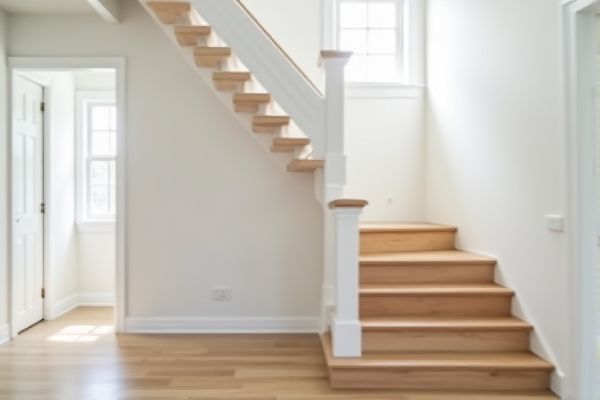
White treads offer a bright, clean appearance ideal for modern or minimalist stair designs, while natural treads showcase the wood's inherent grain and warmth, enhancing traditional or rustic interiors. Explore the rest of the article to discover which option best suits Your home's style and functional needs.
Table of Comparison
| Feature | White Treads | Natural Treads |
|---|---|---|
| Material | Synthetic or bleached rubber | Unprocessed natural rubber |
| Durability | High resistance to wear and tear | Moderate, more prone to degradation |
| Grip | Consistent traction on various surfaces | Excellent grip on wet and dry surfaces |
| Appearance | Bright white, clean look | Earthy, natural color variations |
| Maintenance | Easy to clean and maintain | Requires regular conditioning to prevent drying |
| Cost | Generally higher due to processing | Lower cost, more eco-friendly |
| Environmental Impact | Involves chemical processing and bleaching | Biodegradable and sustainable |
Introduction to White vs Natural Treads
White treads offer a clean and modern finish ideal for contemporary interiors, while natural treads emphasize organic textures and warmth from the wood grain. Your choice depends on the desired aesthetic and the level of maintenance preferred, as white treads can show scuffs more easily than natural finishes. Both options provide durability but cater to different design sensibilities and lifestyle needs.
Aesthetic Differences: White Treads vs Natural Treads
White treads offer a sleek, modern look that brightens staircases and complements contemporary interior designs, while natural treads showcase the wood's authentic grain and warm tones, adding rustic charm and organic texture to spaces. The high contrast of white treads can make stairs visually stand out and create a sense of openness, whereas natural treads provide a timeless appearance that blends seamlessly with traditional or farmhouse decor. Choosing between white and natural treads depends on whether you prefer a bold, clean aesthetic or a cozy, natural ambiance.
Pros and Cons of White Stair Treads
White stair treads offer a clean, modern aesthetic that brightens your space and complements various decor styles, making them a popular choice for contemporary homes. They are easy to spot dirt on, promoting regular cleaning, but may show wear and scuffs more visibly than natural wood treads. Choosing white treads can enhance the visual spaciousness of your stairs and require thoughtful maintenance to keep their pristine appearance.
Pros and Cons of Natural Wood Stair Treads
Natural wood stair treads offer a timeless aesthetic, durability, and the ability to refinish for longevity, making them a popular choice for enhancing home value. However, they can be prone to scratches and require regular maintenance to preserve their appearance, unlike white treads that may show less wear but lack the warmth of natural wood. Your decision depends on balancing the classic beauty and repairability of natural wood against the ease of upkeep and uniform look of white treads.
Durability and Maintenance Comparison
White treads typically require more frequent cleaning to maintain their bright appearance, as they are prone to visible stains and dirt buildup. Natural treads, made from untreated or minimally treated wood, often offer greater durability due to their resistance to wear and less noticeable signs of aging. Choosing your stair treads depends on balancing aesthetic preferences with the level of maintenance you're willing to commit to for long-term durability.
Cost Analysis: White Treads vs Natural Treads
White treads generally cost more than natural treads due to the additional manufacturing processes and materials used to achieve their bright, uniform appearance. Natural treads, sourced from untreated wood or stone, often provide a budget-friendly option while offering unique patterns and textures. You can balance your design preferences and budget by considering these cost differences alongside the desired aesthetic and durability for your space.
Best Interior Styles for White and Natural Treads
White treads create a crisp, modern aesthetic, ideal for Scandinavian, coastal, and minimalist interior styles that emphasize brightness and clean lines. Natural treads emphasize warmth and texture, complementing rustic, farmhouse, and traditional interiors with their earthy, organic appeal. Both options enhance spatial perception differently: white treads expand light-filled spaces while natural treads ground rooms with rich wood tones.
Cleaning and Upkeep Tips for Each Type
White treads require regular cleaning with non-abrasive cleaners to prevent discoloration and maintain their bright appearance, while natural treads benefit from gentle dusting and occasional polishing to preserve their organic texture. Use a soft cloth or sponge for white treads to avoid scratches, whereas natural treads may need specialized wood or stone cleaners depending on the material. Your maintenance routine should adjust to these differences to ensure longevity and aesthetic appeal for each tread type.
Environmental Impact: Painted vs Natural Finishes
White treads with painted finishes typically involve the use of synthetic chemicals and solvents, contributing to higher environmental pollution and VOC emissions compared to natural treads. Natural treads, often finished with eco-friendly oils or water-based sealants, minimize chemical runoff and reduce carbon footprint through sustainable sourcing. Choosing natural finishes supports better indoor air quality and aligns with green building certifications like LEED and WELL.
Choosing the Right Treads for Your Home
Choosing the right treads for your home depends on durability, aesthetic appeal, and maintenance requirements; white treads offer a modern, clean look that brightens interiors but may show dirt more easily, while natural wood treads provide warmth and timeless elegance with varying grain patterns and shades. Oak, maple, and cherry are popular natural wood options prized for their hardness and longevity, whereas white treads often come in materials like painted wood or laminate that allow for versatile design integration. Evaluating your home's style, traffic levels, and cleaning regimen will help determine whether white or natural treads best complement your living space and functional needs.
 homyna.com
homyna.com